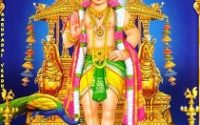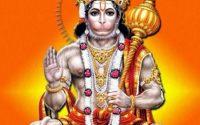Navadurga Names – The 9 Forms of Goddess Durga
Navadurga Names – The 9 Forms of Goddess Durga: Navadurga, also known as the Nine Durgas, refers to a group of nine distinct forms or manifestations of the Hindu goddess Durga. These forms are worshiped during the festival of Navaratri, which is a nine-night festival celebrated in India to honor the goddess Durga. Each of the nine forms of Durga is associated with different attributes, powers, and stories.
According to Hindu mythology, the nine forms are considered the nine stages of Durga during the 9 day long duration of the war with demon king Mahishasura, where the 10th day is celebrated as the Vijayadashami among the Hindus and is considered as one of the most important festivals.
The forms of Navadurga are as follows:
1. Shailaputri
Shailaputri is the first form of the Hindu goddess Durga in the Navadurga group. The name “Shailaputri” is composed of two words: “Shaila,” which means mountain, and “putri,” which means daughter. Thus, Shailaputri is the “daughter of the mountain.” She is also known as “Sati” or “Parvati” in some traditions.
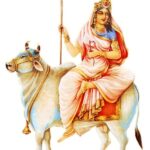 Shailaputri is often depicted riding a bull and holding a trident (trishul) in one hand and a lotus flower in the other. She is a symbol of strength and devotion. This form of Durga represents the power and grace of the mountains, and her worship signifies the power and stability of nature.
Shailaputri is often depicted riding a bull and holding a trident (trishul) in one hand and a lotus flower in the other. She is a symbol of strength and devotion. This form of Durga represents the power and grace of the mountains, and her worship signifies the power and stability of nature.
Shailaputri is associated with the Muladhara Chakra, which is the root chakra located at the base of the spine. This chakra represents the foundation of a person’s existence and is associated with physical strength and stability.
Worshiping Shailaputri during Navaratri is believed to help individuals attain inner strength and stability in their lives. She is also associated with the planet Moon (Chandra) and is said to bring peace and harmony to the lives of her devotees.
2. Brahmacharini
Brahmacharini is the second form of the Hindu goddess Durga in the Navadurga group. The name “Brahmacharini” is derived from two words: “Brahma,” which refers to the Hindu god of creation and “acharini,” which means one who practices or follows. Thus, Brahmacharini can be understood as “one who practices or follows the path of Brahma.”
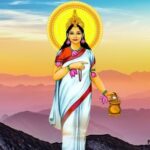 Brahmacharini is often depicted as a young woman who is deep in meditation and austerity. She is typically portrayed wearing white clothes and holding a rosary (japa mala) in one hand and a water pot (kamandalu) in the other. She is known for her penance and self-control, symbolizing the pursuit of knowledge, wisdom, and spirituality.
Brahmacharini is often depicted as a young woman who is deep in meditation and austerity. She is typically portrayed wearing white clothes and holding a rosary (japa mala) in one hand and a water pot (kamandalu) in the other. She is known for her penance and self-control, symbolizing the pursuit of knowledge, wisdom, and spirituality.
This form of Durga is associated with tapas (austerity), dedication to spiritual knowledge, and a disciplined way of life.
Worshiping Brahmacharini during Navaratri is believed to bestow qualities such as inner strength, devotion, and a focused mind. It is also considered auspicious for those seeking self-realization and knowledge. Brahmacharini’s worship signifies the importance of a disciplined and ascetic lifestyle in the pursuit of spiritual growth and enlightenment.
3. Chandraghanta
Chandraghanta is the third form of the Hindu goddess Durga in the Navadurga group. The name “Chandraghanta” is derived from two words: “Chandra,” which means moon, and “ghanta,” which means bell. Thus, Chandraghanta can be translated as “She who has a moon-shaped bell.”
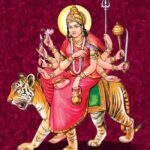 Chandraghanta is often depicted with a crescent moon on her forehead, giving her the appearance of a bell. She is typically depicted riding a lion and has ten arms that hold various weapons and symbols, including a trident, sword, bow, and arrow. Her appearance is formidable and symbolizes bravery and courage.
Chandraghanta is often depicted with a crescent moon on her forehead, giving her the appearance of a bell. She is typically depicted riding a lion and has ten arms that hold various weapons and symbols, including a trident, sword, bow, and arrow. Her appearance is formidable and symbolizes bravery and courage.
Chandraghanta is associated with qualities such as peace, serenity, and bravery. Her worship during Navaratri is believed to bring strength, protection, and the ability to face challenges with courage. Devotees believe that she destroys their enemies and dispels negative energies.
This form of Durga is also associated with the Manipura Chakra, which is the solar plexus chakra. It represents the qualities of inner power, confidence, and courage. Worshiping Chandraghanta during Navaratri is thought to help individuals harness their inner strength and achieve personal growth.
4. Kushmanda
Kushmanda is the fourth form of the Hindu goddess Durga in the Navadurga group. The name “Kushmanda” is derived from two words: “Ku,” which means “a little,” and “ushma,” which means “warmth” or “energy.” Thus, Kushmanda can be translated as “the cosmic egg” or “the one who creates the universe.”
 Kushmanda is often depicted as a radiant goddess with eight arms, riding on a lion. She is associated with the creation of the universe and is believed to have brought light to the cosmic darkness. In her hands, she holds various objects, including a pot of divine nectar (amrita), a lotus flower, a mace, a bow, and an arrow.
Kushmanda is often depicted as a radiant goddess with eight arms, riding on a lion. She is associated with the creation of the universe and is believed to have brought light to the cosmic darkness. In her hands, she holds various objects, including a pot of divine nectar (amrita), a lotus flower, a mace, a bow, and an arrow.
Devotees worship Kushmanda during Navaratri to seek her blessings for health, energy, and prosperity. She is considered the source of all creation and is believed to provide the energy and power necessary to sustain life on Earth. Her worship is said to bring positivity, happiness, and a sense of well-being to those who seek her blessings.
Kushmanda is also associated with the Anahata Chakra, which is the heart chakra. This chakra represents love, compassion, and the opening of the heart to universal love. Worshipping Kushmanda is believed to open one’s heart and increase feelings of love and compassion.
5. Skandamata
Skandamata is the fifth form of the Hindu goddess Durga in the Navadurga group. The name “Skandamata” is derived from two words: “Skanda,” which is another name for Kartikeya (the god of war and son of Shiva and Parvati), and “mata,” which means mother. Therefore, Skandamata is often translated as “Mother of Skanda.”
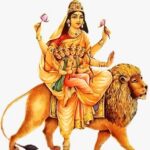 Skandamata is typically depicted as a goddess riding a lion and holding her son, Kartikeya, in her lap. She has four arms, and two of her hands hold lotus flowers, while the other two hold various weapons and symbols. This form of Durga represents motherly love, protection, and nurturing.
Skandamata is typically depicted as a goddess riding a lion and holding her son, Kartikeya, in her lap. She has four arms, and two of her hands hold lotus flowers, while the other two hold various weapons and symbols. This form of Durga represents motherly love, protection, and nurturing.
Devotees worship Skandamata during Navaratri to seek her blessings for the well-being and protection of their children. She is considered the caring and loving mother who watches over her children and ensures their safety. Her worship is believed to bring strength, courage, and protection to families.
Skandamata is associated with the Vishuddha Chakra, which is the throat chakra, and represents communication, expression, and the power of the spoken word. Worshipping Skandamata is thought to enhance one’s communication skills and help them express themselves with clarity and compassion.
6. Katyayani
Katyayani is the sixth form of the Hindu goddess Durga in the Navadurga group. She is believed to have manifested to fulfill the wishes and prayers of the sage Katyayana, who sought a daughter as powerful as Durga to defeat the demon Mahishasura. Katyayani is often depicted as a fierce and warrior-like goddess.
Typically, Katyayani is portrayed with four to eighteen arms, holding various weapons and symbols. She is often shown riding a lion, symbolizing her fearlessness and valor. The weapons she carries, such as a sword, trident, and lotus, represent her combat abilities and her ability to conquer evil forces.
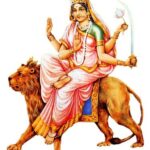 Katyayani’s worship during Navaratri is particularly significant for those seeking courage, strength, and the ability to face challenges with determination. Devotees believe that she provides protection and helps in overcoming obstacles.
Katyayani’s worship during Navaratri is particularly significant for those seeking courage, strength, and the ability to face challenges with determination. Devotees believe that she provides protection and helps in overcoming obstacles.
Her worship is also associated with the Muladhara Chakra, the root chakra, which represents the foundation of one’s existence and the awakening of primal energy.
Katyayani is revered for her ability to destroy the forces of darkness and ignorance and is considered a powerful and determined goddess who safeguards her devotees from harm and adversity.
7. Kalaratri
Kalaratri is the seventh form of the Hindu goddess Durga in the Navadurga group. Her name “Kalaratri” can be translated to mean “the night of time” or “the dark night.” She is often depicted as a fierce and formidable goddess, associated with darkness and destruction.
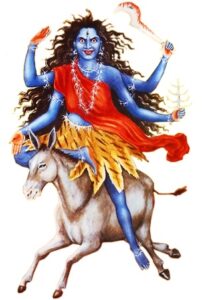 Kalaratri is typically depicted with a dark complexion and wild, disheveled hair. She has four arms, and in her hands, she carries a sword and a noose. She rides a donkey or a mule, and her appearance is fearsome, signifying her power to annihilate evil and ignorance.
Kalaratri is typically depicted with a dark complexion and wild, disheveled hair. She has four arms, and in her hands, she carries a sword and a noose. She rides a donkey or a mule, and her appearance is fearsome, signifying her power to annihilate evil and ignorance.
The worship of Kalaratri during Navaratri symbolizes the triumph of light over darkness and the victory of good over evil. Devotees seek her blessings to overcome challenges, remove obstacles, and protect themselves from negative forces. Her worship is believed to instill fearlessness, strength, and the ability to confront adversity with unwavering determination.
Kalaratri is associated with the Manipura Chakra, which is the solar plexus chakra located in the abdomen. This chakra represents personal power, self-confidence, and transformation. Worshipping Kalaratri is thought to help individuals release their inner potential and overcome any hindrances that may be holding them back.
8. Mahagauri
Mahagauri is the eighth form of the Hindu goddess Durga in the Navadurga group. Her name “Mahagauri” can be translated as “the extremely fair one.” She is often depicted as a radiant and graceful goddess, symbolizing purity and serenity.
Mahagauri is typically portrayed as a young woman with a fair complexion. She is dressed in white attire and is depicted with four arms. In her hands, she carries a trident (Trishul) and a drum (Damaru). She rides a bull, and her demeanor is gentle and serene.
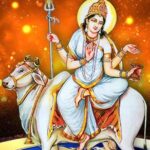 The worship of Mahagauri during Navaratri signifies purity, peace, and forgiveness. Devotees seek her blessings for a pure and peaceful life. Her worship is believed to remove impurities, both external and internal, and bring about a sense of harmony and tranquility.
The worship of Mahagauri during Navaratri signifies purity, peace, and forgiveness. Devotees seek her blessings for a pure and peaceful life. Her worship is believed to remove impurities, both external and internal, and bring about a sense of harmony and tranquility.
She is associated with the Anahata Chakra, the heart chakra, which symbolizes love, compassion, and self-acceptance. Worshiping Mahagauri is thought to open one’s heart to love and understanding.
Mahagauri is considered a compassionate and loving form of Durga who showers her devotees with blessings of inner and outer purity, happiness, and contentment.
9. Siddhidhatri
Siddhidatri is the ninth and final form of the Hindu goddess Durga in the Navadurga group. Her name “Siddhidatri” is derived from two words: “siddhi,” which means supernatural powers or accomplishments, and “datri,” which means giver or bestower. Therefore, Siddhidatri can be translated as “the bestower of supernatural powers.”
Siddhidatri is often depicted with four arms and is seated on a lotus flower. She is depicted holding various objects in her hands, including a mace, a discus (chakra), a conch shell, and a lotus. These attributes represent her divine powers.
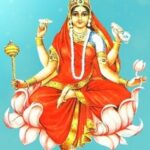 Siddhidatri is believed to grant her devotees various mystical and spiritual powers, including the eight primary siddhis (supernatural abilities) mentioned in Hindu philosophy, such as Anima (the ability to become smaller than the smallest), Mahima (the ability to become larger than the largest), and Garima (the ability to become heavier than the heaviest).
Siddhidatri is believed to grant her devotees various mystical and spiritual powers, including the eight primary siddhis (supernatural abilities) mentioned in Hindu philosophy, such as Anima (the ability to become smaller than the smallest), Mahima (the ability to become larger than the largest), and Garima (the ability to become heavier than the heaviest).
Worshiping Siddhidatri during Navaratri is believed to bestow spiritual wisdom, enlightenment, and the ability to overcome obstacles and challenges in life. Her devotees seek her blessings for success in their spiritual endeavors and the attainment of self-realization.
Siddhidatri’s worship is also associated with the Sahasrara Chakra, the crown chakra, which represents the highest level of consciousness and spiritual awakening. Devotees believe that by worshiping Siddhidatri, they can attain the ultimate state of spiritual realization and union with the divine.
During Navaratri, devotees worship each of these nine forms of Durga on successive days, with the festival culminating in Dussehra, the tenth day, which symbolizes the victory of good over evil. The worship of Navadurga is an important part of Hindu culture and religious practice.

